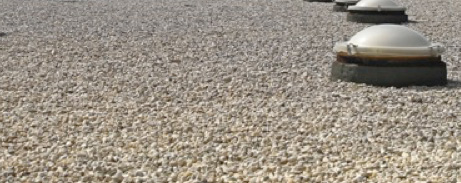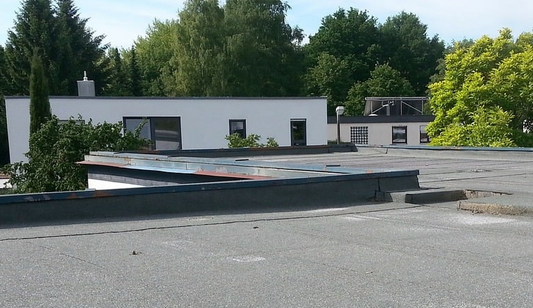A properly installed PVC flat roof will last 20-30 years with typical manufacturer warranties ranging from 15-30 years. You'll get maximum durability from your PVC roof when you combine professional installation with regular maintenance, including monthly debris removal and routine inspections.
These roofs offer excellent resistance to UV radiation, chemicals, and extreme weather while providing energy-efficient benefits through their reflective properties. While the initial cost may be higher than traditional roofing, PVC's minimal maintenance requirements, energy savings, and long lifespan make it a cost-effective investment. Understanding the key factors that affect your roof's longevity can help you maximize its performance.
Key Points
- PVC flat roofs typically last 20-30 years when properly installed and maintained, with manufacturers offering warranties up to 30 years.
- Regular maintenance, quality installation, and environmental conditions directly impact a PVC roof's lifespan and performance.
- PVC roofs are highly durable, resisting chemicals, UV radiation, weathering, and fire while maintaining flexibility in temperature fluctuations.
- The cost-effectiveness of PVC roofs stems from their low maintenance requirements, energy efficiency, and long-term durability.
- Professional installation by certified contractors and routine inspections are crucial for maximizing a PVC roof's lifespan.
Average Lifespan of PVC Roofing
When properly installed and maintained, PVC roofing systems typically last 20-30 years on commercial and residential buildings. You'll find that many manufacturers offer warranty coverage ranging from 15 to 30 years, depending on the membrane thickness and installation quality. These warranties often cover material defects and premature deterioration under normal weather conditions.
To optimize your PVC roof's lifespan, you'll need to follow essential maintenance tips. Schedule professional inspections twice yearly to check for seam separations, punctures, or loose flashings. Keep your roof clean by removing debris, leaves, and standing water that can accelerate wear.
You should also trim overhanging branches that could damage the membrane during storms.
The actual longevity of your PVC roof depends on several factors, including local climate, installation quality, and maintenance frequency. In moderate climates with proper care, your roof might exceed the 30-year mark. However, if you're in an area with extreme temperature fluctuations or severe weather, you may need replacement closer to the 20-year mark. Regular maintenance and prompt repairs will help guarantee you get the maximum lifespan from your investment.
Factors Affecting PVC Roof Durability
Several key factors directly impact your PVC roof's durability and performance over time. Understanding these elements will help you maximize your roofing investment and ensure top-notch weather resistance throughout its service life.
| Factor | Impact |
|---|---|
| Installation Quality | Determines seam strength and overall system integrity |
| Material Quality | Affects UV resistance and membrane flexibility |
| Maintenance Level | Influences early problem detection and prevention |
| Environmental Conditions | Determines rate of weathering and degradation |
| Roof Traffic | Affects mechanical wear and tear on membrane |
The material quality of your PVC membrane plays an essential role in its longevity. Higher-grade materials offer superior weather resistance and maintain their physical properties longer than economy options. You'll find that premium PVC membranes typically contain better plasticizers and UV inhibitors, which prevent premature aging and brittleness.
Regular inspections and maintenance significantly prolong your roof's lifespan. You should schedule professional inspections at least twice yearly to identify potential issues before they escalate. Remember that proper drainage design and installation are key - standing water can speed up membrane degradation and potentially void your warranty.
Signs of PVC Roof Wear
Recognizing early warning signs of PVC roof deterioration helps prevent costly structural damage and extends your roofing system's life. You'll want to regularly inspect your PVC roof for membrane shrinkage, cracking at seams, and surface chalking, which are common indicators of age-related wear.
Look for visible signs of weather damage, including punctures from hail, wind-lifted areas, and UV degradation that appears as discoloration or brittleness. Check corners and flashings where the membrane meets walls or equipment, as these areas often show the first signs of separation or stress. Water pooling that remains longer than 48 hours indicates potential drainage issues and can accelerate deterioration.
Your repair options will depend on the type and extent of wear. Small punctures and tears often require simple patch repairs, while more extensive damage might need section replacement. If you notice widespread membrane thinning or multiple failing seams, it's time to evaluate professional assessment.
Don't overlook blistering or bubbling in the membrane – these often indicate trapped moisture beneath the surface and require immediate attention to prevent insulation damage and potential roof failure.
Professional Installation and Performance
Professional installation directly impacts a PVC roof's ability to resist the wear patterns and damage discussed above. When you hire certified contractors, they'll guarantee proper membrane attachment, precise seam welding, and correct flashing installation - all critical factors in roofing performance. These professionals understand the precise temperature requirements for heat welding and how to achieve ideal adhesion between PVC sheets.
Installation quality depends heavily on the contractor's expertise with PVC-specific tools and techniques. You'll want installers who properly prep the substrate, maintain consistent weld temperatures, and perform thorough quality checks on all seams.
They should also integrate appropriate drainage slopes and ensure correct placement of mechanical fasteners to prevent membrane stress.
Your PVC roof's longevity hinges on these installation details. Certified installers will follow manufacturer specifications for overlaps, terminations, and penetration flashings. They'll also provide documentation of installation methods and materials used.
When you invest in professional installation, you're safeguarding against common failures like membrane separation, pooling water, and improper flashing that often result from DIY or inexperienced installations.
Maintaining Your PVC Flat Roof
Regular maintenance tasks form the backbone of PVC flat roof longevity. Through preventive maintenance and routine inspections, you'll protect your investment and maximize your roof's performance. You'll need to conduct thorough assessments at least twice yearly, focusing on seams, flashings, and drainage systems.
- Clear debris monthly from drains, gutters, and scuppers to prevent water pooling and potential membrane damage
- Check seams and lap joints quarterly for signs of separation or deterioration
- Inspect penetrations and flashings every six months for proper adhesion and potential leak points
- Remove any sharp objects, branches, or materials that could puncture the membrane immediately
You'll want to document all inspections and repairs for warranty purposes and future reference. When you notice issues like discoloration, bubbling, or separation at the seams, contact a qualified PVC roofing professional immediately. Small problems can quickly escalate into major repairs if left unchecked. Remember to avoid using harsh chemicals or abrasive tools during cleaning, as these can damage the membrane's surface. Instead, use manufacturer-approved cleaning solutions and soft-bristled brushes when necessary.
Cost Versus Long-Term Benefits
Initially, PVC flat roof installation costs more than traditional roofing options, with prices ranging from £45 - 75 per M2 isntalled. However, when you perform a thorough cost analysis over the roof's lifetime, you'll find that PVC roofing offers significant financial advantages.
You'll save money through reduced maintenance requirements, lower energy costs, and fewer repairs. PVC roofs typically last 20-30 years, which means you won't need to replace your roof as frequently as with conventional materials.
Additionally, the material's resistance to chemical exposure, fire, and extreme weather conditions means you'll spend less on emergency repairs and insurance premiums. When you factor in these long-term benefits, the higher upfront cost becomes a strategic investment that pays off over time.




